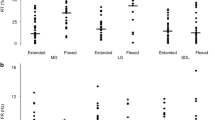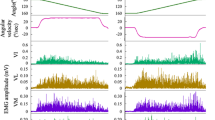Summary
Synergistic behaviour of triceps surae muscles (medial gastrocnemius-MG, lateral gastrocnemius-LG, soleus-SOL) during sustained submaximal plantarflexions was investigated in this study. Six male subjects were asked to sustain an isometric plantar flexor effort to exhaustion at two different knee angles. Exhaustion was defined as the point when they could no longer maintain the required tension. The loads sustained at 0 and 120 degrees of knee flexion represented 50% and 36% of their maximum voluntary contraction (MVC) respectively. MVC was measured at 0 degree knee flexion. During the contractions, electromyograms (EMG) from the surface of the triceps surae muscles were recorded. Changes in the synergistic behaviour of the triceps surae were assessed via partial correlations of the average EMG (AEMG) between three muscle combinations; MG/LG, MG/SOL, LG/SOL, and correlation between SOL/MG+LG and MG/SOL+LG. The latter combinations were based on either common fibre type or innervation properties. Two types of synergisms were identified: trade-off and coactivation. Trade-off and coactivation synergies were defined by significant (p<0.05) positive and negative correlations respectively. Coactivation synergism was found to occur predominantly under conditions of high load or reduced length of the triceps surae, and increased with the duration of the contraction. Trade-off synergism was evident when the muscles were at their optimum length and the loads sustained were submaximum. Complete shutdown of one muscle activity was ruled out. It is postulated that, in the absence of voluntary strategies on the part of the subjects, changes in the syznergistic behaviour of the triceps surae muscles, manifested through trade-off and coactivation, is dependent on the load placed on the muscle and the muscle effectiveness as characterized by the force/length curve.
Similar content being viewed by others
References
Basmajian JV, DeLuca CJ (1985) Muscles alive. Williams and Wilkins. Baltimore
Bower JS, Sandercock TG, Rothman E, Albbrecht PM, Dantzkes DR (1984) Time domain analysis of diaphragmatic electromyogram during fatigue in men. J Appl Physiol 57:913–916
Clark GT, Carter MC (1985) Electromyographic study of human jaw-closing muscle endurance, fatigue and recovery at various isometric force levels. Arch Oral Biol 30:563–569
Gellhorn E (1947) Patterns of muscular activity in man. Arch Physiol Med 28:568–574
Hellsing G, Lindstrom L (1983) Rotation of synergistic activity during isometric jaw closing muscle contraction in man. Acta Physiol Scand 118:203–207
Hof AL, VanDenBerg J (1977) Linearity between the weighted sum of the EMGs of the human triceps surae and the total torque. J Biomech 10:529–539
Lippold OCJ (1955) Fatigue in finger muscles. J Physiol 128:33
Lippold OCJ, Redfearn JWT, Vuco J (1960) The electromyography of fatigue. Ergonomics 2:121–131
Lopes JM, Mulle NL, Bryan MH, Bryan AC (1981) Synergistic behaviour of inspiratory muscles after diaphragmatic fatigue in the newborn. J Appl Physiol 51:547–551
Sirin A, Patla AE, Frank JS, Green H, Hughson R (1984) EMG characteristics of synergistic muscles during submaximal contractions to fatigue. Proc 3rd biannual conference of the Canadian Society for Biomechanics, Human Locomotion III, Winnipeg, 47–48
Sirin A (1985) Synergistic behaviour of the triceps surae during sustained submaximal contractions. M. Sc. Thesis, University of Waterloo, Waterloo
Viitasalo JHT (1982) Function of the knee extensor muscles during fatigue. In: Matsui H, Kobayashi K (Eds), Biomechanics VIII. University Park Press, Baltimore, pp 271–277
Weathersby HT (1966) The forearm stabilizers of the thumb: An electromyographic study. Anat Rec 154:439
Author information
Authors and Affiliations
Rights and permissions
About this article
Cite this article
Sirin, A.V., Patla, A.E. Myoelectric changes in the triceps surae muscles under sustained contractions. Europ. J. Appl. Physiol. 56, 238–244 (1987). https://doi.org/10.1007/BF00640651
Accepted:
Issue Date:
DOI: https://doi.org/10.1007/BF00640651




